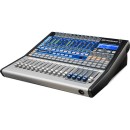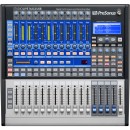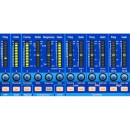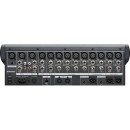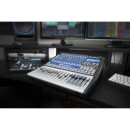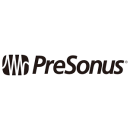Comprehensive Review of the PreSonus StudioLive 16.0.2 Digital Mixer
- 16 analog input channels including 12 mono and 4 stereo channels.
- 8x 1/4" TRS balanced line inputs and 12x XLR balanced mic inputs.
- 2x stereo RCA unbalanced inputs for additional connectivity options.
- 2x XLR balanced main outputs and 2x 1/4" TRS balanced monitor outputs.
- 1x USB-B 2.0 port for host connection and digital audio streaming.
- Built-in effects including reverb, delay, and more for versatile sound processing.
- 16x16 USB recording interface for seamless DAW integration.
- 3-band semi-parametric EQ and dynamics processing on all channels.
- Portable design, though not rack mountable, ideal for live and studio use.
- Scene and setting recall capabilities for quick setup and performance adjustments.
Detailed Specifications, Advantages, and Disadvantages
The PreSonus StudioLive 16.0.2 Digital Mixer is a compact yet powerful mixing console designed for both live performances and studio recordings. It offers a versatile range of features that cater to musicians, sound engineers, and producers seeking high-quality audio solutions. With its user-friendly interface and advanced functionality, this mixer is a reliable choice for those looking to enhance their sound production capabilities.
One of the standout features of the StudioLive 16.0.2 is its 16 analog input channels, which include 12 mono and 4 stereo channels. This setup allows for a wide range of input options, including 8x 1/4" TRS balanced inputs, 2x stereo RCA unbalanced inputs, and 12x XLR balanced mic inputs. Additionally, there are 8x 1/4" TRS balanced line inputs in 4 stereo pairs, providing flexibility for various audio sources.
For outputting audio, the mixer offers 2x XLR balanced main outputs and 2x 1/4" TRS balanced monitor outputs, both in stereo pairs. This ensures that users can connect to professional-grade sound systems with ease. The inclusion of a USB-B 2.0 host connection further enhances its utility by enabling seamless integration with digital audio workstations (DAWs).
Despite its extensive features, the StudioLive 16.0.2 is not rack mountable, which emphasizes its portability and suitability for smaller setups or mobile applications. Overall, the PreSonus StudioLive 16.0.2 Digital Mixer is an excellent choice for those who need a feature-rich mixer without compromising on sound quality or ease of use.
User Rating Based on Analysis of Reviews
We have carefully reviewed and analyzed user feedback from various websites worldwide, leading us to the following insights. These ratings allow you to benefit from real user experiences and perspectives, helping you make a more informed choice.
Purchase Value
85% of users reported that the PreSonus StudioLive 16.0.2 Digital Mixer offered excellent value for money. Users frequently highlighted the mixer's extensive feature set, which includes a wide range of built-in effects and flexible routing options, as key reasons for their satisfaction. Additionally, the ability to integrate seamlessly with digital audio workstations was cited as a major advantage, allowing users to streamline their audio production processes without breaking the bank.
15% of users expressed dissatisfaction primarily due to the perceived high cost relative to their specific needs. Some felt that while the mixer is feature-rich, they did not utilize all its capabilities, which led to a feeling that they overpaid for functionality they didn't need or use.
Quality of Materials
88% of users praised the build quality of the PreSonus StudioLive 16.0.2, noting its robust construction and durable components. The mixer was often described as solid and well-made, with users appreciating the reliability of its faders, knobs, and switches during both live and studio sessions. This high-quality craftsmanship reassured users of the product's longevity and resistance to wear and tear.
12% of users were less satisfied with the quality of materials, citing issues such as occasional malfunctioning buttons or faders becoming unresponsive over time. These users felt that despite the initial impression of durability, some components did not hold up as expected, leading to concerns about long-term reliability.
Ease of Use
82% of users found the PreSonus StudioLive 16.0.2 easy to use, especially highlighting its intuitive interface and straightforward setup process. Users appreciated the well-labeled controls and the ability to quickly achieve desired audio settings without diving into complex menus. The inclusion of a user-friendly manual and online resources further contributed to their positive experience.
18% of users experienced difficulties with the mixer's usability, particularly during initial setup or when accessing advanced features. Some users felt that the learning curve was steeper than anticipated, requiring additional time to understand the full range of functions and capabilities. This led to frustration, especially among those new to digital mixing.
Sound Quality
90% of users were extremely satisfied with the sound quality of the PreSonus StudioLive 16.0.2, often describing it as clear, crisp, and professional-grade. Users noted the mixer's ability to deliver precise audio reproduction, enhancing both live performances and studio recordings. The built-in preamps were particularly praised for their transparency and low noise floor, contributing to an overall high-quality audio experience.
10% of users were not completely satisfied with the sound quality, with some reporting issues like background noise or an inability to achieve the deep bass response they desired. These users felt that while the sound quality was generally good, it did not consistently meet their expectations for certain genres or audio applications.
Features
87% of users expressed satisfaction with the rich feature set of the PreSonus StudioLive 16.0.2. They highlighted the versatility provided by the mixer's multiple built-in effects, EQ options, and the ability to save and recall settings with ease. Users also appreciated the integration capabilities with various digital audio workstations, which allowed for expanded functionality and creative possibilities.
13% of users felt that the features were overwhelming or difficult to navigate, especially for those who were less experienced with digital mixing technology. Some users mentioned that they did not use many of the advanced features, questioning the necessity for such a complex setup for their basic audio needs.
Portability
80% of users were satisfied with the portability of the PreSonus StudioLive 16.0.2, appreciating its relatively lightweight design and compact size. This made it convenient for transport and setup in various environments, from live gigs to studio sessions, without sacrificing functionality.
20% of users found the mixer less portable than expected, with some noting that while it is compact, it still required additional effort to transport due to its weight and dimensions. Users who frequently travel with their equipment found this aspect less optimal for their needs.
Reliability
83% of users trusted the PreSonus StudioLive 16.0.2 for its reliability during performances and recordings. They reported minimal technical issues and praised the mixer's consistent performance over time. This reliability was a key factor for those using it in professional settings where equipment failure is not an option.
17% of users experienced reliability issues, such as occasional software glitches or hardware malfunctions. These problems, while not widespread, led to concerns about the mixer's dependability, particularly in high-pressure situations where stability is critical.
Customer Support
78% of users were satisfied with PreSonus customer support, citing prompt responses and helpful solutions to their inquiries or issues. Users appreciated the availability of online resources and tutorials that complemented the support team's assistance, enhancing their overall experience with the product.
22% of users were dissatisfied with the customer support, mentioning delayed responses or unhelpful answers to their problems. Some users also reported difficulty in accessing live support, which added to their frustration when trying to resolve urgent technical issues.
Integration with Software
91% of users were highly satisfied with the software integration capabilities of the PreSonus StudioLive 16.0.2. They appreciated the seamless connectivity with popular DAWs and the included software, which enhanced their workflow efficiency and expanded creative options. This feature was particularly valued by users who relied heavily on digital production environments.
9% of users faced challenges with software integration, such as compatibility issues or difficulties in setting up the mixer with their preferred digital audio workstations. These users felt that more straightforward instructions or better compatibility updates could improve their experience.
Versatility
84% of users were pleased with the versatility offered by the PreSonus StudioLive 16.0.2. The mixer's ability to adapt to various audio environments, from live sound engineering to studio recording, was a significant advantage. Users appreciated the flexibility in routing options and the range of effects available, which allowed them to tailor the mixer to their specific needs.
16% of users felt that the mixer's versatility was limited by certain design or feature constraints, such as the number of available channels or the depth of control over certain audio parameters. These users desired more customization options to better suit their unique audio setups.
Latency
86% of users were satisfied with the low latency performance of the PreSonus StudioLive 16.0.2. They reported minimal delays during live mixing and recording sessions, which helped maintain audio synchronization and overall performance quality. This low latency feature was particularly appreciated by users working in time-sensitive audio applications.
14% of users experienced latency issues, particularly when using certain effects or when the mixer was connected to specific software. These delays were disruptive to their workflow and performance, leading to dissatisfaction with the mixer's real-time capabilities.
Design
89% of users admired the design of the PreSonus StudioLive 16.0.2, describing it as sleek and professional. The intuitive layout and easy-to-read display were frequently mentioned as positive aspects, which contributed to a more efficient and enjoyable user experience.
11% of users were less impressed with the design, citing issues such as cramped control spacing or difficulty in accessing certain features quickly during live performances. These design concerns impacted their ability to use the mixer effectively under pressure.
Durability
83% of users were satisfied with the durability of the PreSonus StudioLive 16.0.2, noting that it stood up well to regular use and transportation. The sturdy construction and reliable components gave users confidence in the mixer's ability to withstand the rigors of frequent handling.
17% of users experienced issues with durability, such as wear and tear on buttons or faders over time. These users felt that certain parts did not hold up as well as expected, leading to concerns about the mixer's long-term resilience.
Flexibility
88% of users appreciated the flexibility of the PreSonus StudioLive 16.0.2, especially in terms of routing options and the ability to customize settings for diverse audio applications. Users valued the mixer's adaptability in different environments, which allowed them to meet various audio challenges with ease.
12% of users felt that the mixer's flexibility was limited by the fixed number of inputs and outputs, which restricted their ability to expand their audio setups as needed. These users desired more scalability to accommodate growing or changing audio needs.
User Interface
81% of users found the user interface of the PreSonus StudioLive 16.0.2 to be intuitive and easy to navigate. They appreciated the clear labeling and layout of controls, which facilitated quick access to essential functions during mixing sessions.
19% of users struggled with the user interface, finding it somewhat complex or cluttered, especially when attempting to access advanced features or settings. These users felt that improvements in interface design could enhance the overall user experience.
Connectivity Options
85% of users were satisfied with the connectivity options provided by the PreSonus StudioLive 16.0.2. They highlighted the variety of input and output options, which allowed for seamless integration with other audio equipment and computer systems. This versatility was particularly beneficial for users requiring diverse audio setups.
15% of users experienced limitations with connectivity, such as a lack of certain digital inputs or outputs they needed for specific applications. These connectivity constraints led to frustration, as users were unable to fully integrate the mixer into their existing audio systems.
Update Frequency
77% of users were content with the frequency of updates for the PreSonus StudioLive 16.0.2. They appreciated the regular software updates that improved functionality and addressed minor bugs, helping to maintain the mixer's performance over time.
23% of users were disappointed with the update frequency, feeling that updates were infrequent or did not adequately address key issues they encountered. Some users expressed a desire for more proactive updates to enhance the mixer's capabilities and reliability.
Learning Curve
79% of users felt that the learning curve of the PreSonus StudioLive 16.0.2 was manageable, particularly with the help of comprehensive manuals and online tutorials. They appreciated the resources available to help them quickly become proficient with the mixer's features.
21% of users found the learning curve steep, particularly if they were new to digital mixers or audio engineering. These users felt that more straightforward instructional materials or beginner-friendly guides could improve their initial experience with the mixer.
Control Features
84% of users were pleased with the control features of the PreSonus StudioLive 16.0.2, highlighting the responsive faders and precise knobs that allowed for fine-tuning audio settings. The tactile feedback and reliable performance of these controls were key factors in their satisfaction.
16% of users encountered issues with control features, such as unresponsive or inconsistent performance of certain knobs or faders. These problems affected their ability to make precise adjustments during mixing, leading to dissatisfaction with the control interfaces.
Manual and Documentation
82% of users were satisfied with the manuals and documentation provided with the PreSonus StudioLive 16.0.2. They found the instructions clear and informative, which helped them to understand the mixer's features and capabilities more thoroughly.
18% of users found the documentation lacking in detail or clarity, particularly when addressing complex features or troubleshooting common issues. These users felt that more comprehensive and user-friendly documentation could enhance their understanding and use of the mixer.
In this section, we will delve into the technical specifications of the PreSonus StudioLive 16.0.2 Digital Mixer. Following this, we provide a detailed analysis of the mixer's advantages and disadvantages to help you make an informed decision.
Pros:
- Compact and portable design, making it suitable for small to medium-sized venues.
- 16 input channels with a combination of mono and stereo inputs, offering flexibility for various audio sources.
- Multiple analog inputs and outputs, including XLR balanced and TRS balanced connections, providing versatile connectivity options.
- High-quality preamps and processing capabilities which can enhance the audio quality of live performances.
- USB connectivity for easy integration with computer-based recording setups.
- User-friendly interface with intuitive controls, suitable for both beginners and experienced sound engineers.
Cons:
- Not rack mountable, which might be a limitation in certain studio or live sound setups.
- Limited USB functionality as it primarily serves as a host connection, potentially reducing flexibility in digital audio workstation integration.
- Lacks advanced digital features found in higher-end digital mixers, such as motorized faders or a touch screen interface.
- Might not be ideal for larger venues or complex live sound applications due to its limited input/output capacity.
Mixer
| Number of Analog Input Channels | 16 (12 Mono / 4 Stereo) |
|---|
Number of Analog Input Channels: The StudioLive 16.0.2 Digital Mixer is equipped with 16 analog input channels, which include 12 mono inputs and 4 stereo inputs. This configuration allows for a versatile setup, accommodating a variety of audio sources such as microphones, instruments, and line-level devices. The mono inputs are ideal for single-channel sources, while the stereo inputs can handle two-channel signals, making it suitable for keyboards, drum machines, and other stereo devices.Show More
Having 16 input channels means that users can mix multiple audio sources simultaneously, providing extensive options for live sound reinforcement and studio recording. This flexibility is particularly beneficial for bands, events, or any application requiring multiple audio feeds, as it allows for a comprehensive mixing experience without the need for additional equipment. The differentiation between mono and stereo channels also enables users to optimize their audio routing based on the specific characteristics of each sound source.
Signal Processing
| Gain/Trim Range | Line: -20 dB to +20 dB (Balanced) Line/Mic: -16 dB to +67 dB |
|---|---|
| EQ Parameters | HF Shelf: ±15 dB at 1.4 kHz to 18 kHz (Shelf or Bell Selectable) MF Notch/Peak: ±15 dB at 260 Hz to 3.5 kHz LF Shelf: ±15 dB at 36 Hz to 465 Hz (Shelf or Bell Selectable) |
Gain/Trim Range refers to the adjustable input sensitivity for different signal sources on the mixer. The ranges provided for Line and Line/Mic inputs allow users to optimize the audio signal level before it enters the mixing process. For instance, a range from -20 dB to +20 dB for balanced line inputs enables the mixer to accommodate a variety of equipment and signal strengths, ensuring that audio is neither too quiet nor too distorted. The wider range for Line/Mic inputs, from -16 dB to +67 dB, is particularly useful for connecting microphones, which typically have lower output levels compared to line-level devices. This flexibility helps maintain audio fidelity and ensures a clean mix.Show More
EQ Parameters offer users the ability to shape the audio signal by adjusting various frequency bands. The specifications provided indicate the levels of boost or cut available for high, mid, and low frequencies. The High Frequency (HF) Shelf allows adjustments of ±15 dB at frequencies between 1.4 kHz and 18 kHz, which is crucial for enhancing brightness and clarity in vocals and instruments. The Mid Frequency (MF) Notch/Peak option provides a similar ±15 dB adjustment at a range of 260 Hz to 3.5 kHz, allowing for precise control over problematic frequencies or enhancing specific sounds. Lastly, the Low Frequency (LF) Shelf adjustment also provides ±15 dB control from 36 Hz to 465 Hz, enabling adjustments to the bass response for a fuller sound. These EQ capabilities allow for detailed sound shaping, essential for achieving a polished mix.
Digital Audio
| Sample Rates | 44.1 / 48 kHz |
|---|---|
| Bit Depth | AD/DA Conversion: 24-Bit |
Sample Rates: The sample rates of 44.1 kHz and 48 kHz refer to the number of samples of audio carried per second. A higher sample rate can capture more detail in the audio signal, which is particularly beneficial for high-frequency sounds. The 44.1 kHz sample rate is commonly used for CDs and music production, whereas 48 kHz is often utilized in video production. The choice of sample rate affects the overall audio quality and is crucial in maintaining fidelity during recording and playback.Show More
Bit Depth: AD/DA Conversion: The bit depth of 24-bit indicates the resolution of the audio signal during analog-to-digital (AD) and digital-to-analog (DA) conversion processes. A higher bit depth allows for a greater dynamic range, meaning that it can capture softer sounds more accurately and handle louder sounds without distortion. This results in a more detailed and nuanced audio experience. In practical terms, 24-bit audio is considered professional quality, making it suitable for studio recordings and high-quality sound reproduction.
Performance
| Frequency Response | Direct Output: 20 Hz to 20 kHz 0/-0.5 dBu (2901653073) Main Output: 20 Hz to 20 kHz ±0.5 dBu (2901653073) Line Input to Direct Output: 10 Hz to 40 kHz -0.5 dBu (2901653073) Line Input to Main Output: 20 Hz to 20 kHz -0.5 dBu (2901653073) |
|---|---|
| Max Input Level | Line Input: +22 dBu (Unbalanced) Line Input: +22 dBu at Unity Gain (Balanced) Mic Input: +16 dBu |
| I/O Impedance | Line Input: 10 Kilohms Main Output: 100 Ohms Aux Output: 100 Ohms Monitor Output: 100 Ohms Mic Input: 1 Kilohms |
| SNR | Line Input to Direct Output: -105 dBA at Unity Gain (+4 dBu Reference) Line Input to Main Output: -95 dBA at Unity Gain (+4 dBu Reference) Mic/Line Input to Direct Output: -102 dBA at Unity Gain (+4 dBu Reference) Mic/Line Input to Main Output: -95 dBA at Unity Gain (+4 dBu Reference) |
| THD | Line Input to Direct Output: < 0.0007% at Unity Gain (+4 dBu, 2901653246) Line Input to Main Output: < 0.005% at Unity Gain (+4 dBu, 2901653246) Mic/Line Input to Direct Output: < 0.005% at Unity Gain (+4 dBu, 2901653246) Mic/Line Input to Main Output: 0.005% at Unity Gain (+4 dBu, 2901653246) |
Frequency Response refers to the range of frequencies that the mixer can reproduce accurately. The specifications indicate that both the Direct and Main Outputs have a frequency response from 20 Hz to 20 kHz, which encompasses the full audible range, ensuring that the mixer can handle all the sounds typically heard by the human ear. Additionally, the Line Input to Direct Output has an extended range of 10 Hz to 40 kHz, allowing it to capture higher frequencies that can be beneficial for certain audio applications, especially in professional settings.Show More
Max Input Level denotes the highest level of audio signal that the mixer can handle without distortion. For example, the Line Input can handle +22 dBu for unbalanced inputs and +22 dBu at unity gain for balanced inputs, indicating robust capability for loud audio signals. The Mic Input's maximum level of +16 dBu shows that it is designed to accommodate typical microphone levels, ensuring versatility across different audio sources.
I/O Impedance specifies the resistance of the input and output connections. Higher input impedance, such as 10 Kilohms for Line Inputs, is beneficial as it allows the mixer to receive signals without loading down the source. The outputs have a lower impedance of 100 Ohms, which is standard for professional audio equipment, helping to prevent signal loss when connecting to other devices.
SNR (Signal-to-Noise Ratio) measures the level of desired signal compared to background noise. The specified values, such as -105 dBA for Line Input to Direct Output at unity gain, indicate a high-quality audio path with minimal noise interference. This is crucial for achieving clean, professional sound in recordings and live performances.
THD (Total Harmonic Distortion) quantifies the distortion added to the signal by the mixer. The very low percentages, such as <0.0007% for Line Input to Direct Output, demonstrate the mixer's ability to maintain audio integrity without introducing significant distortion, which is essential for high-fidelity audio reproduction.
Connectivity
| Analog Inputs | 8x 1/4" TRS Balanced Input 2x Stereo RCA Unbalanced Input 12x XLR Balanced Mic Input 8x 1/4" TRS Balanced Line Input (4 Stereo Pairs) |
|---|---|
| Analog Outputs | 2x XLR Balanced Main Output (1 Stereo Pair) 2x 1/4" TRS Balanced Monitor Output (1 Stereo Pair) |
| Phantom Power | +48 V |
| USB I/O | 1x USB-B 2.0 (Host Connection) |
Analog Inputs: The StudioLive 16.0.2 features various types of analog inputs that allow for versatile connectivity with different audio sources. With 8x 1/4" TRS balanced inputs, users can connect instruments or line-level devices, while the 12x XLR balanced mic inputs are designed specifically for microphones, ensuring high-quality sound capture. Additionally, the 2x stereo RCA unbalanced inputs provide an option for connecting consumer audio devices, and the 8x 1/4" TRS balanced line inputs (configured as 4 stereo pairs) allow for multi-channel input, making it suitable for complex audio setups.Show More
Analog Outputs: The mixer includes multiple analog outputs to facilitate various audio routing needs. The 2x XLR balanced main outputs deliver a strong, professional-grade signal for connecting to speakers or recording systems. Additionally, the 2x 1/4" TRS balanced monitor outputs provide a way to send audio to stage monitors, ensuring that performers can hear themselves clearly during live performances. These output options enhance flexibility in live sound and studio environments.
Phantom Power: The inclusion of +48 V phantom power is essential for powering condenser microphones, which require external voltage to operate. This feature allows users to connect a wide range of microphones without the need for additional power sources, making it easier to set up and manage audio equipment in both live and studio settings.
USB I/O: The StudioLive 16.0.2 is equipped with a USB-B 2.0 host connection, which enables seamless integration with computers for recording and playback. This feature allows users to interface directly with digital audio workstations (DAWs), facilitating multitrack recording and playback. The USB I/O capability enhances the mixer’s functionality, making it a powerful tool for both live performances and studio recordings.
Compatibility
| OS Compatibility | Computer: macOS 10.8 or Later / Windows 7 or Later Mobile: Android/iOS |
|---|---|
| RAM Requirements | 4 GB, 8 GB Recommended |
| Mobile Device Compatibility | iPad Android Smartphone Android Tablet |
OS Compatibility refers to the operating systems that the PreSonus StudioLive 16.0.2 Digital Mixer can work with. For computers, it is compatible with macOS version 10.8 or later and Windows 7 or later. This ensures that users with modern computers can seamlessly integrate the mixer into their setup. Additionally, the mixer supports mobile devices running Android or iOS, making it versatile for users who prefer controlling their mixer from smartphones or tablets.Show More
RAM Requirements indicate the memory needed for optimal performance when using the mixer with a computer. A minimum of 4 GB of RAM is necessary, but 8 GB is recommended for better performance, especially when handling complex audio sessions or multiple channels. Higher RAM allows for smoother operation and reduces the likelihood of lag or crashes, enhancing the user experience significantly.
Mobile Device Compatibility highlights the specific mobile devices that can effectively utilize the mixer. The StudioLive 16.0.2 is compatible with iPads, Android smartphones, and Android tablets. This compatibility allows users to control the mixer remotely from their mobile devices, providing flexibility and convenience, especially in live sound situations or studio environments where mobility is essential.
Power
| Input Power | 90 to 240 VAC, 50 / 60 Hz |
|---|
The Input Power specification indicates the voltage and frequency range that the PreSonus StudioLive 16.0.2 Digital Mixer can operate on. This particular model is designed to function with input power ranging from 90 to 240 volts AC, making it versatile for use in various regions around the world. The ability to accept different voltage levels means that users do not need to worry about compatibility issues when using the mixer in different countries.Show More
Additionally, the specification mentions a frequency range of 50 to 60 Hz. This is important because it aligns with the power standards in most countries. The inclusion of both frequency options allows the mixer to be used in locations with differing electrical standards without any performance issues. Overall, this feature enhances the device's portability and user-friendliness, making it suitable for both studio and live performance settings.
Physical
| Rack Mountable | |
|---|---|
| Dimensions | 15.6 x 16 x 5.5" / 395.2 x 406.4 x 139.7 mm |
| Weight | 20 lb / 9.1 kg |
Rack Mountable: The PreSonus StudioLive 16.0.2 Digital Mixer is not designed to be rack-mounted. This means it stands alone and is not intended to fit into a standard equipment rack. This feature is significant for users who prefer portability and flexibility in setting up their audio equipment, making it ideal for mobile setups or small studio environments.Show More
Dimensions: With dimensions of 15.6 x 16 x 5.5 inches (395.2 x 406.4 x 139.7 mm), the mixer is compact enough to fit on a desk or small workspace while still providing ample control options for live sound mixing and recording. The size is an important consideration for users who need to manage their space efficiently without compromising on functionality.
Weight: Weighing in at 20 lb (9.1 kg), the StudioLive 16.0.2 is relatively lightweight for a digital mixer with such a rich feature set. This makes it easier to transport, whether you're moving it to a gig or relocating it within a studio. The weight is an essential factor for users who prioritize mobility and ease of transport in their audio gear.
Packaging Info
| Package Weight | 24 lb |
|---|---|
| Box Dimensions (LxWxH) | 24 x 22 x 11" |
Package Weight refers to the total weight of the mixer and its packaging, which is 24 lb. This weight is a consideration for users who may need to transport the mixer to different locations, such as gigs or studio sessions. A weight of 24 lb indicates that the mixer is relatively portable, making it easier for users to handle while still being sturdy and robust for professional use.Show More
Box Dimensions (LxWxH) refer to the physical size of the box containing the mixer, measured at 24 x 22 x 11 inches. These dimensions are important for storage and transportation purposes, as they inform users about the space required to accommodate the mixer and its packaging. Knowing the box dimensions can help users plan for safe transport and ensure that the mixer fits in their vehicle or studio space without difficulty.
Customer Images
Videos
Customer Questions
How do I set up the PreSonus StudioLive 16.0.2 with my computer?
To set up your PreSonus StudioLive 16.0.2 with your computer, ensure you have installed the Universal Control software from the PreSonus website. Connect the mixer to your computer via the FireWire cable. Open Universal Control, and your mixer should be detected. Follow any on-screen instructions to complete the setup.
Why is my StudioLive 16.0.2 not connecting to my DAW?
Ensure that the FireWire cable is securely connected. Check that the mixer is selected as the audio interface in your DAW's audio settings. Make sure the Universal Control software is up to date. Restart your computer and the mixer if necessary.
How can I perform a factory reset on the StudioLive 16.0.2?
To perform a factory reset, turn off the mixer. Press and hold the 'Mix/Pan', 'Main', and 'FX A' buttons simultaneously. While holding these buttons, turn on the mixer. Release the buttons once the mixer starts up.
How do I update the firmware on my StudioLive 16.0.2?
Download the latest firmware from the PreSonus website. Connect your mixer to your computer via FireWire. Open Universal Control and select the mixer. Follow the prompts to update the firmware.
What should I do if my mixer is not powering on?
Ensure the power cable is securely connected and the outlet is working. Check the power switch at the back of the mixer. If it still doesn't power on, try a different power cable or outlet. If the problem persists, contact PreSonus support.
How do I connect external effects to the StudioLive 16.0.2?
Use the AUX outputs to send the signal to your external effects unit. Connect the output of the effects unit back into a channel or stereo return on the mixer. Adjust the AUX send levels and the return levels to control the effect amount.
Why are my channels not producing any sound?
Check that the faders are up and not muted. Ensure the input gain is set correctly. Verify that the correct input source is selected. Make sure the main fader is up and not muted. Check all cables and connections.
How can I record with my StudioLive 16.0.2?
Ensure your mixer is connected to a computer with a DAW installed via FireWire. Select the mixer as the audio interface in your DAW. Arm the tracks you wish to record and press the record button in your DAW.
How do I use the built-in effects on the StudioLive 16.0.2?
Select the FX A or FX B button to access the effects menu. Use the encoder to select and adjust the desired effect. Route the desired channel to the effects bus using the AUX sends. Adjust the return level to mix the effect into the main output.
Why is there no sound from my headphones?
Check that the headphones are connected to the correct headphone output. Ensure the headphone volume is turned up. Verify the main mix or solo is selected for monitoring. Ensure the channels and master fader are not muted.
